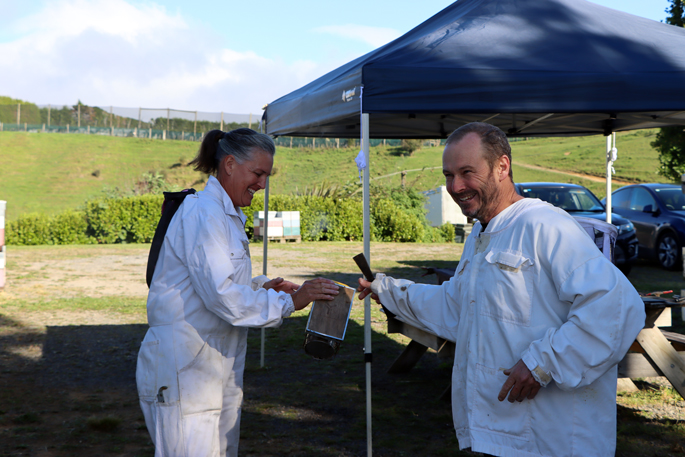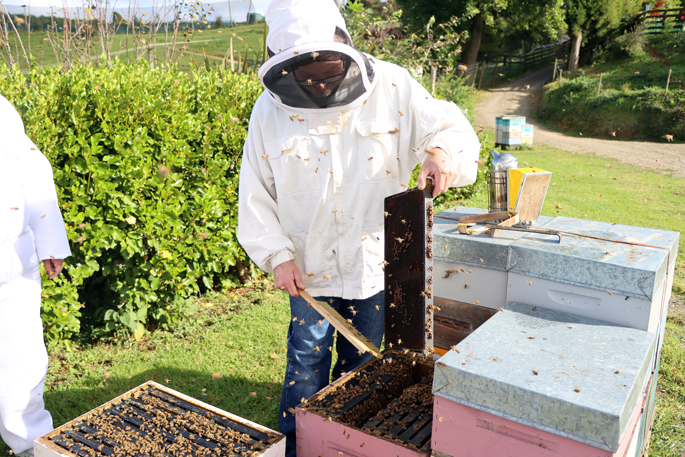As the worker bees mill over hectares of land, pollinating flourishing kiwifruit and avocado orchards, their keepers collect the reward both in dollars and a sense of fulfilment.
Bee First Apiaries, nestled in Whakamarama run by partners Craig Lovell, and Maree Paynter have made pollination work their bread and butter for about the past 10 years.
SunLive was lucky enough to be welcomed by the upbeat and driven duo and learn about the honey harvest as part of the Flavors of Plenty Festival.
Craig and Maree taught the group all about the inner working of hives, but as a novice to the beekeeping world, I was surprised that it’s not actually their hive’s honey that sustains the couple’s livelihood.
Busy bees
“The backbone of our business is pollination work,” says Craig, who has always had an affinity for bees.
“We do a lot of kiwifruit and avocado pollination. That's what keeps us going.”
From October to December, Craig and Maree are as busy as their bees, shifting their hives in the early morning and late at night when the bees aren’t flying.
“We’re loading them onto trucks in the dark and moving them into orchards in the dark. We’re feeding them every morning and then when they're done in the orchard, we're picking them up in the dark, taking them somewhere else and dropping them off.”
Bouncing between more than 30 of their clients’ orchards, Craig says the pollination work is “good fun.”
 Hundreds of Craig Lovell and Maree Paynter’s bees pollinate Bay of Plenty kiwifruit and avocado orchards. Photo: Georgia Minkhorst.
Hundreds of Craig Lovell and Maree Paynter’s bees pollinate Bay of Plenty kiwifruit and avocado orchards. Photo: Georgia Minkhorst.
“It's pretty busy. It’s one of those things that when you're so flogged out, it feels good…you’re pushing hard.”
Craig says orchards can have anywhere between four and 80 of their 800 hives at a time, depending on the orchard size.
“Generally it’s about between 10 to 12 hives per hectare.”
Conventional and organic
For a conventional kiwifruit orchard, the hives will be kept on the land for about 10 days for the bees to do all their pollinating.
“Organic kiwifruit can be about two weeks, and for avocados they're in there for a month or 28 days. It just depends on the variety, the species and whether they're organic or conventional.”
The reason organic orchards take longer for the bees to pollinate is because the growers don’t use Hi-Cane or hydrogen cyanamide – a plant growth regulator.
“In a conventional orchard, flowering is pretty consistent. You'll get good male and female synchronisation in the flowering, whereas organic is quite sporadic and scattered with the male and female opening of the flower so it takes longer.”
 Maree Paynter, left, and Craig Lovell kitted up at their Whakamarama farm, ready to get amongst the hives. Photo: Georgia Minkhorst.
Maree Paynter, left, and Craig Lovell kitted up at their Whakamarama farm, ready to get amongst the hives. Photo: Georgia Minkhorst.
Craig advises anyone looking to step into the bee world and pollination work, to start by getting a good mentor and beginning small.
“It's good fun and it's very rewarding –not financially every time, but really rewarding when you get it right, and the weather's good, the bees are working excellently in the orchard and the growers are happy.
“It's a job where you're ‘earthing’ every day. You're involved with nature right at the grassroots level, where everything begins at pollination. It’s pretty special.”



0 comments
Leave a Comment
You must be logged in to make a comment.